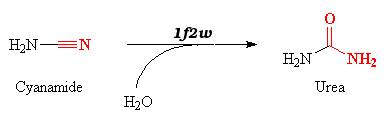Introduction
1f2w is a human protein from the Carbonic anhydrase II (gene name CA2) sub-sub-family, which is one of the fourteen isoforms of human α carbonic anhydrases.
This enzyme is a lyase, which is able to break C-N links, and needs its cofactor, the zinc ion, to be activated.
Carbonic anhydrase II is located in the cytosol, and normally catalyzes the reversible hydration of CO2 into bicarbonate:

But in this representation, we observe the carbonic anhydrase II bound to its suicide substrate, the cyanamide, which is hydrated by the enzyme, forming urea. The urea-carbonic anhydrase II complex leads to the inactivation of the enzyme.
Cyanamide is an organic compound, which formula is :

Cyanamide is a toxic compound mainly found in pesticides or drugs. It exists as two tautomers, the NCNH2 form dominating the other one. Cyanamide is produced by hydrolysis of calcium cyanamide.
Structure
The carbonic anhydrase II is composed of 259 amino acids, and its dimensions are 42Å x 42Å x 72Å.
The protein is composed of :
- 5
- 15
The protein's active site is formed of (residues 94,96 and 119) that can bind a zinc ion. The active site is located in an hydrophobic hole :
Image:125.png
There are two binding sites for mercury :
- .
- .
We can see here the conservation of the residues:

The most conserved residues are located in the active site's cavity.
Function
In this complex, 1f2w catalyzes the hydration of cyanamide into urea according to the equation :

Cyanamide is a toxic compound, and is an analog of CO2. It can thereby bind the active site of the carbonic anhydrase II thanks to the zinc ion.
The reaction is a suicide inhibition: the enzyme binds an suicide substrate (here cyanamide), and this substrate is modified by the enzyme (here into urea) and produces a reactive group that forms a stable inhibitor-enzyme complex.
The inactivation of the carbonic anhydrase II leads to health issues. In fact, it can cause several diseases, such as osteopetrosis autosomal recessive type 3 (also known as Guibaud-Vainsel syndrome). This syndrome is associated with renal tubular acidosis, cerebral calcification (marble brain disease) and in some cases with mental retardation.
Mechanism of Action
The can bind the metal ion and two threonine residues (THR 199 and 200), it is thereby adding to the coordination sphere. The cyanamid attacks the zinc ion (nucleophilic attack). Afertwards the water molecule performs a nucleophilic attack on the zinc-activated cyanamide substrate forming urea which remains bound to the zinc ion.
Urea is tightly linked to the carbonic anhydrase II, acting in this way as an inhibitor.



